|
|
.. |
| Churnet Valley Vets Factsheets
Which pet to choose?
Choosing a Dog
Choosing a Cat
Choosing a Rabbit
What about a Small Furry?
Small Furry Facts
Caring for your rabbit
Guinea pigs as pets
Pet Insurance
Get your free 4 weeks insurance with Petplan here...
Neutering your pets
Neutering (Spaying / Castration)
Spay (Ovario-hysterectomy)
Castration (orchiectomy)
Neutering Rabbits
Pets (Pet Travel Scheme)
Pets Passport
Dental care for dogs and
cats
Firework phobias |
|
Choosing
a Dog
Considering purchasing a new puppy?
Completely confused at which breed would suit your
lifestyle best? Do your research and the time will be
well spent as bringing a dog into your home can affect
the family for potentially the next ten to fifteen
years.
What the pup requires from you....
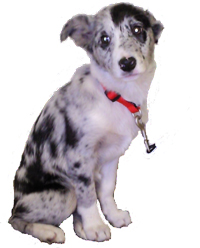
There are many breeds of dog that offer a selection of behavioural and
personality traits. However, there are certain requirements that apply to all types of dog and
careful consideration of these points can help decide if a dog, or a breed, suits you best and
matches your lifestyle.
Time & Commitment
Dogs are social animals that need lots of attention especially to avoid behavioral problems
and also require training, exercise and grooming. If you expect that you will be leaving a dog
on its own for more than four hours on a regular basis then you may need to reconsider your
choice of pet.
Space and Exercise
The size of your house and garden will need to be considered, as will your ability to provide
your dog with exercise. Different breeds of dog have different exercise requirements - some
are content with a short walk every day but others need several hours a day. 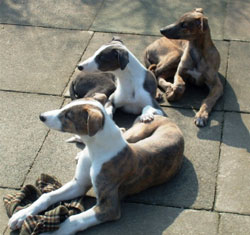
Expense
There are one off and ongoing expenses to bear in mind. These include:
The initial cost of your puppy/adult dog
Daily costs of feeding (especially the larger breeds)
Budget for veterinary fees / insurance premium costs
Kenneling / care costs during holidays
Grooming fees for some breeds
Experience
Have you kept a dog before? There are easier breeds and there are more demanding breeds
to care for.
Reasons for Having a Dog
Are you hoping for a protective, working or companion dog?
Making that Choice
There are rough guides to each breed available from books, websites or by visiting pet shows.
Our veterinary surgeries will be able to offer advice and guidance.
Points to remember:
Purebred vs. crossbred?
It is possible to look at information on a particular breed and have an idea of what to expect -
with crossbreeds this is more difficult to judge however it is fair to say some diseases are
strongly linked to some purebreds.
Size / image issues
Big dogs generally need more space, possibly more exercise, more food and often have a shorter
life expectancy than many smaller breeds. Each breed has its own image - somebody walking a
Chihuahua sends a different message to someone out walking with a Mastiff.
Male or female?
Male dogs tend to be larger than their female partners and are more prone to being competitive
with other dogs, bitches will have a season twice a year unless spayed. These all bring their own
set of issues. 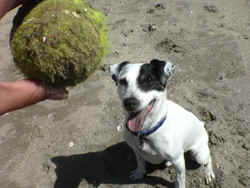
Coat
Long hair or short hair? Long coated breeds such as Afghans need a lot of grooming attention but
other shorter haired breeds may shed hair at every step. Some dogs will need regular clipping -
often at a professional grooming parlor to maintain a healthy and attractive coat.
Age
Puppies are fun, haven't learnt any bad habits yet (?) and you get to watch them grow up but come
lacking toilet training and with some playful but possibly destructive behavior (like chewing your
favorite shoes). Older dogs come with a little more training (hopefully) and you avoid the messy
years but you should be cautious about the reasons why it now requires a home.
Back to Top
|
What breed would be best for you and your family?
There are two excellent websites we recommend you check
before taking this life changing purchase:
www.ufaw.org.uk/geneticwelfareproblems.php
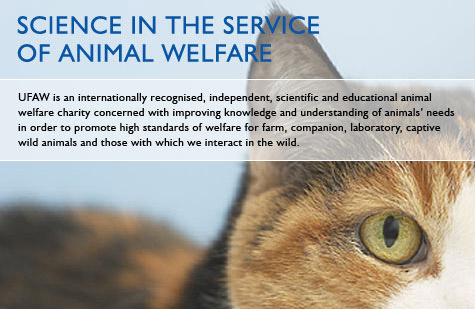
This excellent website has a list of pedigree dogs and
their known problems – bear in mind that some of these
conditions are extremely rare and your puppy is by no
means certain or even necessarily likely to develop it!
Other species, such as cats, rabbits, horses, guinea
pigs are also covered in this website.
Another useful website is
www.dogbreedhealth.com
“The website is an excellent way of informing the public
of what to look for when buying a puppy or dog and
provides easy to understand information on health
issues. Really anyone thinking about taking on the
responsibility of owning a dog should look at this
website to ensure they know what it entails and what
pitfalls there are when making a breed choice.”
Neil Parish MP, Chairman of the Associate Parliamentary
Group for Animal Welfare (APGAW)
Choosing the right pup from the right litter
Checking out those puppies:
There are golden rules we suggest you follow when
choosing a puppy, whether it be from a pedigree breeder,
a dog’s home or from a family home:
-
Certain breeds have known genetic problems ie hip
dysplasia in German Shepherds. By only using dogs and
bitches who are free of these problems can the condition
can be eliminated. When choosing a pup ask the breeder
if the parents have had the relevant checks and have
been deemed clear of the condition. IF IN DOUBT
TELEPHONE US AT CHURNET VETS AND WE WILL ADVISE YOU OF
THE QUESTIONS YOU NEED TO ASK.
Only buy from a
responsible and reputable breeder.
-
Choose the cocky puppy from the litter – being softies
we humans tend to favour the ‘underdog’ and go for the
puppy who is cowering under the table and won’t come out
when you approach them. If you are an experienced dog
owner and do not have children then this pup may be the
challenge you relish, but if you are a first time owner
and have children then perhaps you would be better
choosing the confident puppy who is not likely to suffer
from fear aggression in a family situation.
-
Insist on meeting the pup’s mum if possibly – puppies
learn everything they know from their mum and if she is
unsocialised in the house and distrustful of humans then
she will pass this on to her pups. If the mum and pups
have been socialised in a house with lots of
people-contact then the puppy will be better adjusted
when taken away from the security of the litter. It’s a
good sign if the bitch allows you to handle the pups and
they are comfortable with this. It is not often possible
to meet the dad, but if you can it is useful to check
that he does not have any aggression problems.
-
The socialisation period, ie the first twelve weeks of a
pup’s life, is hugely important in affecting how the pup
will react to new and potentially stressful situations
for the rest of its life. It is important that the pup
is exposed to lots of different stimuli, in a
comfortable way (if the pup is stressed with lots of
different stimuli in this period then it has a negative
effect on the pup). If the puppy is being well
socialised in the breeder’s home then it is good if they
can stay with their mum until they are about 8 weeks old
– if you are concerned that the pups are not being
socialised you may be best getting the pup as early as
six weeks and taking the time to socialize the puppy
yourself
-
Certain breeds have known genetic problems ie hip
dysplasia in German Shepherds. By only using dogs and
bitches who are free of these problems can the condition
can be eliminated. When choosing a pup ask the breeder
if the parents have had the relevant checks and have
been deemed clear of the condition. IF IN DOUBT
TELEPHONE US AT CHURNET VETS AND WE WILL ADVISE YOU OF
THE QUESTIONS YOU NEED TO ASK. Only buy from a
responsible and reputable breeder.
The time you put into your pup in the first few months
is hugely influential on the chances of success of the
relationship between your new pup and your family. Do
you have the time and commitment to do this work?
Back to Top
|
Choosing a Cat
Cats come in a selection of shapes and styles - long haired, short haired,
striped or pointed. They all have a special appeal either because they are independent and aloof
or because they are cuddly and sociable. 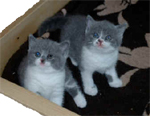
Care points for cats include consideration for exercise - access to the outside, need for company
and fees such as vets bills, insurance premiums and cattery charges. Whilst the food bills for a
cat may be less than a dog the cost of cat litter (if used) needs to be considered.
Moggies and Pedigree cats
There are approximately 40 different breeds of cat with about 500 varieties. The breeds
come in four groups:
Longhair
Shorthair
Siamese
Foreign shorthair
Each breed has its own general characteristics such as the placid, sociable Persian or the noisy,
busy Siamese. Moggies come in all shapes, colours and coat types. Sometimes they are more
resistant to diseases thus having a slightly longer life expectancy.
Making That Choice
Long hair or short hair?
A commitment to daily grooming is needed from the owners of a long haired cat to prevent matting
of its coat and the development of fur balls. Short haired cats can still get fur balls and shed
hair so they will also need some grooming. 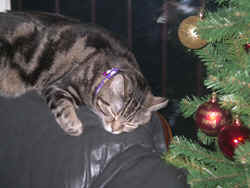
Male or female? - Male cats (toms) are generally larger than their female partners and
there is usually a marked difference in behavior between the toms and female cats (queens).
Fighting is a frequent behavior seen in tom cats as they fight over territory and queens.
This often results in war wounds and infections. Many toms are castrated for this reason.
Castration is also part of responsible pet ownership as un-neutered roaming toms will sire many
litters of kitten, many which become strays.
Un-neutered queens will come into season regularly and give birth to several litters a year if
allowed to do so. Again this often results in many unwanted kittens. You should have her spayed
unless she is of show standard and you wish to breed from her.
|
Back
to Top
Choosing a Rabbit
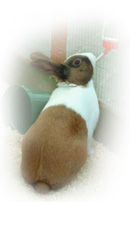
Rabbits come in all shapes and sizes i.e. small, medium or large, a coat
of one colour or several, erect ears or droopy etc. Many people now keep their pet rabbit
indoors as they can make ideal house pets. They can be toilet trained and a few modifications
will make your home safe. However, they are more traditionally kept outside under shelter in
the winter months and in the garden during the summer months.
Picture courtesy of Supreme Petfoods Ltd
Making that Choice
Time & Commitment
Rabbits need attention every day. The benefits of this are in terms of effects on their
behavior and good health. The more a rabbit is handled and in contact with humans the
friendlier they become. It is also important to check over pet rabbits regularly for things
like overgrown teeth, overgrown toenails and messy bottoms. The hutch or pen will need
cleaning weekly and bedding replaced or topped up daily. House rabbits need attention to their
pen daily. Rabbits should be groomed weekly, or more frequently for the long haired varieties.
Space & Exercise
Outdoor rabbits need accommodation to protect them from harsh weather and also to provide them
with space for a sleeping area, food area and toileting area. They should have access to
grass, preferably with a run that allows them to stand up on their hind legs and to bounce
around. If the weather is good and the garden is secure from escape check that the rabbit is
safe from cats and dogs and let them have a run around in the garden - provided you are
present to keep an eye on them. Indoor rabbits need a pen that is large enough to allow them
to lie down stretched out. If the rabbit is likely to spend a significant period of time shut
in then the pen should be larger. Indoor rabbits should also have access to the garden in
summer.
Expense
Pet rabbits are usually available at a fair price - but show standard purebreds will be more
expensive. Other costs of the rabbits include:
Vaccinations
There are two vaccinations available to protect your pet. There is a vaccine available to
protect against myxomatosis infection and another available to protect against a viral
diarrhea disease.
Company
Rabbits do like company, in the wild they would live in a large group. Acceptance of a mate,
male or female, is best achieved when the rabbits are still young. Plenty of human contact
will provide your rabbit with stimulation and company . |
Back
to Top
What about a Small Furry?
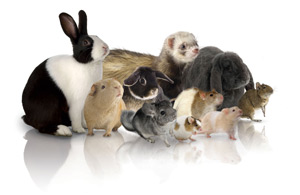
If you don't have the time to care for a cat or dog but still
want a pet for yourself or your children you might consider one of the following:
Picture courtesy of Supreme
Petfoods Ltd
Guinea Pigs
What's involved: Guinea pigs are clever and socialable pets. They don't need
a high space because they don't jump or climb but they do need a lot of floorspace. They
need a temperature between 18-26 degrees C and so in winter they should be housed indoors.
Guinea pigs should be fed twice daily with a high fibrous diet and vitamin C (this is why guinea
pig food is different to rabbit food - guinea pigs must have added vitamin C in their food).
Guinea pigs love to have companions - littermates or single sex guineas (not rabbits).
Hamsters
What's involved: Hamsters are very clever and adventurous - they are determined
escape artists. They must live in a wire cage (they will gnaw their way out of a wood or
plastic cage). Hamsters need lots of toys and frequent handling to keep them tame and
socialised. They are naturally nocturnal so play with them in the evening. Hamsters
are omnivorous, they hoard food and need chewing material to keep their teeth short. Some
species of hamsters like to live along (eg Syrian) and some prefer a companion (dwarf hamsters).
Gerbils
What's involved: Gerbils are friendly and inquisitive. The ideal gerbil house is a
gerbilarium, made of glass with a lid containing ventilation holes but secure to prevent escapes.
Gerbils eat seeds, grains, roots and insects in the wild. They are very active and in
the wild live in tunnels in the desert sand. They need very little water but their supply
should be fresh. They are not smelly pets as they are adapted to preserve water and their
faeces are dry. They like a thick layer of sawdust, or something similar, to tunnel in and
when in a glass aquarium or the like they can be very entertaining to watch. They can be
handled if not taken by surprise.
Rats
What's involved: Rats are very intelligent and agile. They should be housed indoors
with a large wire cage. The cage should be high enough to allow them two levels. Rats
are omnivores and need protein. They should not be fed human food or nuts. They need
feeding once a day and need cleaning out regularly as they hoard food. Rats are nocturnal
and so will be playful in the evening. They enjoy being handled if it is done properly.
They are very sociable creatures and so are best kept with another rat of the same sex,
preferably a litter mate as they can fight if introduced to a new rat.
Chinchillas
What's involved: Chinchillas are very bright, inquisitive and good climbers. They
need a large cage with a climbing area, a sleeping box and a daily fresh sand bath. They are
indoor pets and need a constant temperature above 28 degrees C. Chinchillas are herbivores,
needing a lot of fibre. This helps grind down their constantly growing teeth. They are
very intelligent pets and so need lots of toys for stimulation. They are sociable and like
to be with a single sex group.
|
Smally Furry Facts
|
Rabbits |
Guinea pigs |
Hamsters |
Gerbils |
| Latin name |
Oryctolagus
Cuniculus |
Cavia Porcellus |
Mesocricetus
Auratus |
Meriones
Unguiculatus |
| Female |
Doe |
Sow |
Sow |
Sow |
| Male |
Buck |
Boar |
Boar |
Boar |
| Young |
Kittens |
Piglets |
Pups |
Pups |
| Life span |
5-10 yrs |
5-8 yrs |
1-3 yrs |
3-5 yrs |
| Litter size |
4-12 kittens |
1-6 piglets |
3-12 pups |
3-10 pups |
| Birth wt |
30-80g |
70-100g |
2-3g |
1-3g |
| Eyes open |
10 days |
at birth |
12-14 days |
17 days |
Gestation
period |
30-33 days |
59-72 days |
15-18 days |
24-26 days |
| Average wt |
Male 1-5kg
female 1-8kg |
Male and female
750-1000g |
Male 85-130g
Female 95-150g |
Male 60g
Female 50g |
Sexual
maturity |
16-24 wks |
45-70 days |
Male 6-8 wks
Female 4 wks |
Male and female
10-12 wks |
Weaning
age |
4-7wks |
3 wks |
3 wks |
21-24 days |
| Diet |
Herbivores |
Herbivores |
Omnivores |
Omnivores |
|
Rats |
Chinchillas |
Ferrets |
|
| Latin name |
Rattus Norvegicus |
Chinchilla Lanigera |
Mustela Putorius Furo |
|
| Female |
Doe |
Doe |
Jill |
|
| Male |
Buck |
Buck |
Hob |
|
| Young |
Pups |
Kits |
Kits |
|
| Life span |
2-4 yrs |
10-20 yrs |
5-11 yrs |
|
| Litter size |
6-16 pups |
1-6 kits |
5-13 kits |
|
| Birth wt |
5-7g |
30-40g |
8-10g |
|
| Eyes open |
10-16 days |
at birth |
From 4 weeks |
|
Gestation
period |
20-22 days |
111-113 days |
38-44 days |
|
| Average wt |
Male and female
400-800g |
Male 400-500g
Female 400-600g |
Male 700-2000g
Female 600-900g |
|
Sexual
maturity |
Male and female
6-10 wks |
4-12 mths
(average 8mths) |
Male 5-9 mths
Female - spring after birth |
|
Weaning
age |
3-4 wks |
8-10 wks |
6-8 wks |
|
| Diet |
Omnivores |
Herbivores |
Carnivorous |
|
Information courtesy of
Supreme Petfoods Ltd
Back to Top
|
Caring for your rabbit
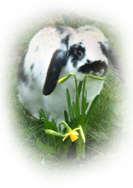 In the wild
rabbits eat a range of grasses, weeks, leaves, shoots and twigs as well as the bark of trees,
shrubs and bushes. Rabbits are herbivores and their digestive system has evolved to be
extremely efficient with the ability to eliminate indigestible fibre rapidly and ferment those
fibres that are digestible. Rabbits need a balanced diet with high levels of fibre to
keep them healthy. In the wild
rabbits eat a range of grasses, weeks, leaves, shoots and twigs as well as the bark of trees,
shrubs and bushes. Rabbits are herbivores and their digestive system has evolved to be
extremely efficient with the ability to eliminate indigestible fibre rapidly and ferment those
fibres that are digestible. Rabbits need a balanced diet with high levels of fibre to
keep them healthy.
As foragers rabbits must be fed twice a day every day. The traditional
rabbit mix sold in pet shops was originally designed to fatten rabbits up for the pot post war
- some contain chocolate drops and inappropriate components, leading to obesity and overgrown
teeth. Supreme Russel Rabbit food is designed to fulfil all of the dietary requirements
of a pet rabbit. This can be bought in the surgery.
Picture courtesy of Supreme
Petfoods Ltd
Rabbit with normal incisors
It is important the right diet is offered to pet rabbits so as to keep the teeth working hard
and help prevent them from overgrowing and becoming a problem. If they do become overlong they
curl into the gums and teeth causing big problems with eating. Routine examination of pet
rabbits should be carried out by the owner (an adult not a child). If the teeth appear to be
causing a problem it is important your take the rabbit for a veterinary health check.
Faeces
Because rabbits eat food high in cellulose (plant fibre), like grass and hay, some of the food
they eat has to pass through the digestive system twice. Some of the faeces passed overnight
are very soft and pale in colour and contain high amounts of this fibre. These are called
caecophytes and are eaten by the rabbit to go through the digestive process a second time.
This makes it easier to get the nutrients out of the tough fibre.
Fly strike
Any rabbit left to sit in damp and dirty surroundings is prone to disease which is why it is
important to clean hutches and pens regularly. This is especially important in the summer when
flies seek places to lay eggs. It is important to clean rabbits living spaces daily in the
summer and to check the rabbit all over at the end of the each day. Fly eggs are very small,
white and oval and they stick very strongly to the animal's hair. If these eggs are not
removed and are allowed to hatch out (often overnight) they produce maggots. These maggots
rapidly cause unbelievable injuries and pain to the animal. During the warmer months rabbits
should be checked over by the owner once a day.
Myxomatosis
this is a disease transmitted by fleas, or from contract with other infected rabbits.
Symptoms are usually swollen eyelids and thick discharge from the eyes and nose.
The rabbit will become very subdued and stop eating. This condition is usually
fatal. Vaccination each year can prevent this disease.
Snuffles/pasteurella
This is a bacterial condition and can be related to stress. The rabbit will develop
coldlike symptoms with a runny nose, breathing difficulties and discharge from the eyes.
Snuffles can lead to more sericous problems such as pneumonia, head tilt and tooth rot
abscesses. The hutch should be kept well ventilated and at a constant temperature,
removing wet bedding to reduce stress.
Back to Top
|
Guinea pigs as pets
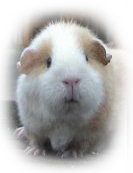 Guinea pigs are
relatively trouble free and make very good pets for children. Long haired guinea pigs do need
grooming and this should be taken into account when choosing your guinea pig. Guinea pigs are
relatively trouble free and make very good pets for children. Long haired guinea pigs do need
grooming and this should be taken into account when choosing your guinea pig.
Guinea pigs can live for up to 7 years and so this needs to be a
consideration when you decide to buy one for your children – you may be left caring for
them long after the kids have left home! Always buy from a reputable pet shop or breeder and
pick the one that looks healthy, is bright and friendly. The guinea pig should be at least six
weeks old.
Picture courtesy of Supreme
Petfoods Ltd
What do guinea pigs need?
- Companionship - to be with other guinea pigs. Guinea pigs are sociable
creatures and prefer to be with the company of other guinea pigs – the same sex of course!
(unless you are prepared to get them neutered).The widespread practice of keeping guinea pigs and
rabbits together is not recommended.
Feeding twice a day, with a mixture
of meadow hay, green stuff, pellets, washed fruit and vegetables.
A constant supply of fresh, clean
drinking water in a drip feed bottle with a metal spout.
Guinea pigs can be kept as indoor
pets but care must be taken as they can chew electric cables, furniture etc. Ideally your guinea
pig should be kept outside in a large hutch with an outside run. A large weatherproof home kept
off the ground, out of direct sunlight and strong winds. It should be moved to an indoor area or
porch in cold weather.
A separate sleeping area for each animal inside the home.
A clean layer of wood chippings on the floor of their home and plenty of soft
hay for bedding and burrowing.
Daily exercise in a grassy area safe from predators and an indoor run in cold
weather.
Their home to be cleaned every day and bedding changed weekly.
A gnawing block to wear down long teeth.
To be brushed every day if they have a long or rough-haired coat.
Some quiet time alone or with other guinea pigs every day.
To be taken to a vet if they are ill or injured.
To be looked after when you are on holiday.
Handling
Approach the guinea pig from the front and on its level. Pick it up using both hands, one
around the hindquarters,the other around its shoulders (for a young guinea pig) or around its
chest (for an adult). Guinea pigs may become upset by too much handling.
Health
Guinea pigs should be checked regularly for overgrown claws and teeth. Both can be trimmed by
a vet.
Too much scratching results from skin problems and is often caused by mites or lice. We can
provide suitable treatment for these.
Long-haired guinea pigs in particular may suffer from the potentially fatal disease flystrike,
caused by flies laying eggs in soiled fur. Make sure the guinea pigs' home is cleaned every
day and bedding changed regularly. Groom guinea pigs every day, checking their fur all over
for any dirt, especially under the tail.
If a guinea pig develops bald patches on its face, this could indicate the fungal disease
ringworm. In this case bring your pet to see the vet as soon as possible.
Guinea pigs can suffer from vitamin C deficiency, which causes weight loss, general weakness
and swollen joints. Ask us for advice on how to provide your guinea pigs with an adequate
supply of this vitamin.
If you have any concerns about your guinea pigs' health, ask us for advice.
Cavy speak
COOING
A soft sound to reassure other guinea pigs all is well or to show enjoyment when being stroked
by a human
SQUEAK
A high pitched, piercing noise can be a sign of fright or pain, or anticipation - for example
at feed time
CHATTERING TEETH
Stay away! This is a warning to other guinea pigs to keep their distance
GURGLING
A sound of contentment and happiness
Back to Top |
Pet Insurance
Why Insure? Veterinary medicine has, in recent
years, become increasingly sophisticated. We are able to diagnose and treat many conditions
that a few years ago would have remained undetected with, often, fatal consequences especially
in the older pet. The down side of these advances is cost. It is not unheard of for treatment
of a case to exceed £1,000.
Costs of Veterinary Treatment. Whilst we try to keep treatment costs
to a reasonable level, below are some real life cases and their cost of treatment here at
Churnet Valley:
Bloated & twisted stomach in a German Shepherd Dog -
£404.91
Cut to the foreleg of a 5 month old puppy - £95.31
Fractured humerus and emergency treatment in a cat £392.98
Diagnosis and 7 months treatment of canine diabetes
£713.94
Exudtive pleurisy in a cat £480.95
Stabilization of a ruptured cruciate ligament in a St.
Bernard £1650.21
One of the most distressing situations we all too frequently find
ourselves in, is where a pet’s problem is curable, but the owner (because of other
financial commitments/difficulties) finds the cost is too high and the pet has to be put to
sleep. A less grave situation is when the owner has to opt for a treatment which is less than
the best treatment available for the pet, owing to money restraints. That’s where pet
insurance comes in: Veterinary Fee Cover can help you avoid such situations. Occasionally, it
will be necessary to refer difficult or complicated cases to veterinary surgeons specialising
in a certain area such as ophthalmology or orthopaedics: this usually involves significant
expense. An initial consultation with a referral vet can cost approximately £75; any
medication is an extra cost. Insurance should cover this too.
When choosing an insurance company, there are a few things you should look
out for, but please try to remember that you get what you pay for:
Check that there is no limit on how long you can claim for
each illness, as chronic conditions can go on for life, not just 12 months. However, it is quite
common to keep the premiums low by terminating any benefits after 12 months. A certain supermarket
pet insurance policy keeps low premiums by stating that a claim must be made within 30 days of
treatment being started (claims made after 30 days may not be honoured).
Be careful to check that the amount of Veterinary Fee Cover
is adequate, over time a single illness can cost many hundreds of pounds. Some policies marketed
as lifetime policies have a maximum amount per condition, a large dog with a chronic illness could
reach this maximum amount in a few years.
Check that your pet will still be covered in later years,
when he or she may need it most, and the premium in those years will still represent good value.
Remember that as your pet gets older, it is more likely to develop long-term illnesses.
Check that congenital and hereditary conditions are
included. Many companies will load premiums following a claim and subsequently place exclusions
for that condition. Other things to check are that dental treatment, behavioural therapy and
alternative therapies are included in the policy.
If you chose to pay by direct debit, some companies will
insist monthly payments are continued even after your pet has died.
Check what won’t be covered.
Vaccinations, neutering and routine treatments such as
worming are usually excluded.
Some companies may exclude complimentary treatments
including homeopathy, herbal medicine or acupuncture. Many policies exclude treatment for
behavioural conditions.
N.B. All insurance companies exclude pre existing conditions.
My last pet was fine, why bother insuring?
Accidents/illness can always happen, and veterinary medicine has advanced
so that there is far more that can be done for a pet these days. As with any insurance policy
you may never need to make a claim, however the stark reality is that 40% of pets have an
insurance claim over a 12-month period. This rises to 60% above 12 years of age. Compare
this to car insurance, where most people claim about once every 6.5 years, or home insurance
once every 4 years.
Third party cover Dog owners are liable for injury, illness or death
of a third party, if the dog is found to be the cause of an incident. If a claim is brought
against an owner it could result in hefty legal bills in order to defend a claim or paying out
compensation. Most policies will give adequate cover for third party liability.
Like the British Small Animal Veterinary Association, this practice
endorses the concept of pet insurance and we thoroughly recommend it to our clients. Our only
interest is to ensure that we never have to compromise the quality of veterinary care on the
basis of cost. A recent survey by the market research company, Mintel, found that 90% of pet
owners with pet insurance say that it is well worth the money. Check out Martin Lewis's
website : www.moneysavingexpert.com
on his advice. There is a pet insurance form on there which makes interesting reading
There are proposal forms for Petplan
available in the waiting room. We recommend Petplan Covered for Life policies as they are
comprehensive (meeting all of the criteria set out above) and the company settles claims
quickly and with the minimum of fuss. If you have any questions please feel free to ask one of
the practice team.

Why Petplan?
Did you know 1 in 3 pets may require unexpected veterinary treatment each
year?* Whilst advances in veterinary medicine mean we can do more for your pet, treatment
costs can soon mount up. We recommend Petplan insurance to all our clients to help cover
unexpected vets bills.
You may be surprised to hear that you are more likely to claim on your pet
insurance than your car or household policies (Allianz Insurance plc). In fact, in our
experience if you are one of the few people who don’t need to claim on your pet insurance
you really are very lucky indeed!
It’s important to be aware that not all pet insurance is the same.
Some policies limit the amount of time or money that you can claim for. Don’t just shop
around on price alone.
At Churnet Valley Vet Clinic we recommend Petplan insurance for the
following reasons:
With Petplan’s Covered for Life guarantee your veterinary fees cover
is renewed each year no matter how much you claim.
Petplan doesn’t place exclusions at renewal on their Covered for Life
policy so on-going conditions such as eczema continue to be covered by the policy.
Petplan won’t increase your premium or excess just because you make a
claim.
Petplan is a pet insurance specialist so they understand the animal market
and work closely with vets, charities and breeders.
Click
here to find out more about the different types of pet insurance.
Why not try before you buy? For 4 weeks free Petplan insurance simply click here and quote our practice reference number
1100184362.
Back to Top
Neutering (Spaying /
Castration)
A common misconception is that neutering will cure behavioral problems in
dogs. Unfortunately this is not the case. Only correct behavioral training will modify a
dog’s behaviour.
Spay
(Ovario-hysterectomy)
Spaying, or neutering, involves the removal of the ovaries and the uterus
(Ovario-hysterectomy). Surgery can be performed from 5½ months of age in both cats and dogs. We
do not spay bitches that are in season as surgery is more risky at that time and, if surgery has
been delayed to after the first season, then the optimum time to spay is 3 months after the
finish of the season.
Frequently asked questions
- 'Will it make my pet fat and lazy?' No. Obesity is due to excessive calorie intake. Weight can be
controlled with proper feeding and exercise.
- 'Shouldn't my pet have a litter first?' No. There is no advantage in allowing your pet to have a
litter and there are potential health problems associated with pregnancy and labor.
Reasons for ...
- There will be no more seasons (no mess or inconvenience).
- She will be unable to get pregnant - so there will be no unwanted offspring.
- The risk of her getting a potentially life-threatening uterine infection
(pyometra) is removed. This is common in older cats and 75% of entire (un-neutered) bitches will
develop womb problems later in life; the vast majority of these will need neutering. Surgery at this
stage carries a much higher risk, as the pet is invariably quite ill.
- The chances of her suffering from hormone induced mammary (breast) cancer can be
reduced. Neutering early in life reduces the incidence of mammary (breast) cancer; it is the most
common form of cancer in the bitch. If neutered early in life the incidence of breast cancer in
bitches is reduced by 3- 7 times.
Reasons against ...
- Weight gain. This is always a worry as this in itself can cause problems.
Neutering doesn't make your pet overweight, too much food does! Once your pet has been neutered food
requirements will lessen; reducing the daily food allowance by a third will help to prevent excess
weight gain. You can monitor your pet’s weight by regular weight checks - the scales at the
surgery are free to use.
- All general anesthetics involve some risks. The risk is smaller in young, fit
animals than in older pets (e.g. those that are ill with a womb infection).
Castration (orchiectomy)
Castration is the surgical removal of the testicles. The operation may be
performed on any male cat from 4½ months onwards. Castration can be done in any male dog from
around 6 months onwards.
Reasons for ...
- Reduction of the desire to stray or roam.
- In cats, castration can reduce: aggressive behavior; territorial marking -
spraying urine to mark territory; the strong, offensive odor of cat urine; and territorial fighting
(so reducing the risk of Feline Leukemia).
- In entire male dogs, some potentially life-threatening medical problems are more
likely to occur e.g. hernias, prostate trouble, testicular tumors. Castration reduces or removes the
danger.
- He will be unable to reproduce - so there will be no unwanted offspring.
Reasons against ...
- Weight gain. This is always a worry as this in itself can cause problems.
Neutering doesn't make your pet overweight, too much food does! Once your pet has been neutered food
requirements will lessen; reducing the daily food allowance by a third will help to prevent excess
weight gain. You can monitor your pet’s weight by regular weight checks - the scales at the
surgery are free to use.
- All general anesthetics involve some risks. The risk is smaller in young, fit
animals than in older pets.
Back to Top
|
Neutering Rabbits
Incidentally have you ever considered having your rabbit neutered?
Neutered rabbits are more social towards one another and relations between owner and rabbit can
be improved. More importantly females can suffer from womb cancer; the incidence is in excess of
80% in rabbits over 4 years of age. If you would like more information about neutering your
rabbit, please contact the clinic.
|
Back to Top
PETS
– (Pet Travel Scheme)

The Government will now allow some pets to re-enter
the UK from certain countries without the need to go through quarantine. This means you may be
able to take your pets on holiday! Of course there are strict conditions that must be met first:
-
Your pet to be
microchipped. The microchip must be implanted before the
rabies vaccination and should meet
International Standards so international machines can read it.
-
A rabies vaccination
AFTER your pet has been microchipped.
Three weeks needs to elapse after the
vaccination before your pet can enter
or re-enter the UK
-
A pet passport to be
issued by your vet
-
Tapeworm treatment
(dogs only) not less than 24 hours or
more than 5 days before returning to UK.
Tick treatment is no longer required
(but is still advisable)
-
In some countries an extra certificate is needed to meet with their own
regulations, this is an export health certificate and DEFRA (Department for the Environment, Farming
and Rural Affairs) will be able to inform you if your pet needs one.
-
|
| PET TRAVEL
SCHEME PRICES: |
| Micro chip |
£18.50 |
| Rabies Vaccination x 1 |
£36.83 |
| Pets Passport |
£54.42 |
| Total |
£109.75 |
|
PETS website: www.defra.gov/animalh/quarantine/pets/index.htm
DEFRA, Export Dept - Telephone for up to date advice on regulations: 01785 231900.
PETS helpline: 0870 241 1710 (Monday – Friday 08:30 – 17:00)
Private business dealing with International Pet Travel – telephone: 01257 795606
& website: www.petsonthemove.co.uk
|
| Back to Top |
Pet Passport
PETS enables pet cats and dogs to enter or re-enter the UK without having to
go through the strict six months quarantine. This is providing that the animal has come from a
qualifying country and meets all the requirements of the scheme. Qualifying countries are
certain countries which are involved in the scheme. A dog or cat may leave the UK, visit one or
more of these countries then return to the UK, providing they meet all the conditions of the
scheme.
This list of qualifying countries is frequently being
updated. Contact DEFRA, for an updated list
of qualifying countries. The conditions of the scheme are to be adhered to precisely. Failure to
do so can lead to your pet becoming impounded and forced into six months of quarantine.
-
Re-entry into the UK
Before your pet is allowed into the UK your travel company will check at the point of embarkation:
its microchip number (this is done using a simple scanner) the official PETS certificate the
certificate of treatment against tapeworm. Providing that all criteria has been met and that all paper work is in order
your pet will be allowed into the UK. Failure of any part will be subject to further checks. If
there are any doubts about its vaccination and health status, it will not be allowed into the UK,
except to go into quarantine. (Visit our own boarding and quarantine kennels on www.chingfordkennels.co.uk) Personal
preparation and organization Do this well in advance. Check that all is in order before you go
abroad with your pet or if you wish to bring your pet into the UK.
- Contact your veterinary surgeon before taking your pet abroad. Only certain
approved routes and transport companies are involved in the PETS travel scheme; check what is
available to you. Your travel company can be contacted for further advice.
- Think about your pet's comfort for all of the journey/stay. Does your cat or dog
become stressed during journeys and/or nervous when in strange places? If so, it may be kinder to
seek alternate arrangements for them at home or book them into a boarding establishment, www.chingfordkennels.co.uk Animals will
die in hot cars so avoid direct sunshine and traveling in high temperatures. Make frequent stops to
allow your dog to relieve itself and for your pet to have a drink. Always make sure your cat or dog
is suitably restrained and secure during the entire journey.
- Check to see if your destination will allow your pet to stay.
- Enquire about a local veterinary surgeon in case of emergencies during your
stay. Your pet may be exposed to diseases which do not normally occur in the UK. In these cases your
pet will not have a natural immunity to fight off such diseases and may become very ill.
Preventative care is available prior to leaving therefore contact your vet on these matters.
- If you are going on a day trip with your pet you will need to have it treated
against tapeworm prior to leaving the UK, so that it is treated 24-48 hours prior to
embarkation to the UK. This will mean you will need to have your pet treated and have the
appropriate certificate before you leave the UK. Your vet will be able to provide you with the
relevant certification.
- Some insurance companies will insure your dog or cat while abroad but this cover
needs to be activated prior to your departing the UK. Check your insurance company to check your
existing policy.
For more information contact your veterinary surgery, travel company
and DEFRA www.defra.gov.uk
Back to Top
|
Dental care
for dogs and cats
If you didn’t clean your teeth regularly would you expect to suffer from dental
problems? Of course you would.
80% of cats and dogs over the age of 7 have significant dental disease.
Bacteria in the mouth form plaque which hardens to form tartar if not cleaned off. This
harbours more bacteria, which cause a bad smell, receding gums and eventually rotten teeth.
Not only is dental disease painful, it also can also lead to lots of other health problems as
a result of bacteria from teeth entering the blood stream. These include abscesses, kidney
disease and heart disease
Toothbrushing is the best solution
How to brush your dog’s teeth
1. First introduce your pet to toothpaste by applying some to your finger or
a toy. Let them lick the toothpaste – they will love the taste. Do this for 3-5 days
2. Next step is to place your finger with the applied toothpaste into your
pet’s mouth and gently massage the teeth and gums. Repeat this until your pet is
comfortable with finger brushing, gradually increasing the areas you are massaging.
3. Try as above using a finger brush (thimble shaped, soft rubber, available
to buy in the surgery). It can take 2-3 weeks to master this.
4. At this stage you should be ready to introduce a toothbrush. Wet the
toothbrush with a small amount of water and push the toothpaste well into the bristles. Start
with just a few teeth, gradually increasing the number as your pet gets used to it.
5. Lift the dog’s lips to clean the molars and premolars, but you do
not need to hold his mouth open. Use an upward and downward motion to gently clean the teeth,
paying attention to where the teeth and gums meet. Start with the back teeth, gradually
making your way to the front. When you have mastered this technique it should become
part of your daily routine, along with th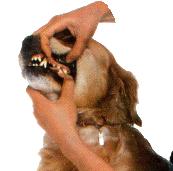 e feeds, walks and cuddles! e feeds, walks and cuddles!
If you have any concerns about this, speak to one of our nurses and she should be able to give
you a demonstation of the technique.
Signs of dental disease
* Bad breath
* Drooling
* Pain when eating
* Eating less
* Weight loss
* Not grooming as much (cats)
* Seeming quiet and withdrawn
Dental treatment
If you notice any of the above signs in your pet, they may need dental treatment. You can
arrange a free nurse appointment to assess the problem. Once tartar has started to build up,
scaling under general anaesthetic is needed to remove it. Often teeth need to be removed - for
example if there is severe gum disease or if the tooth is damaged.
Animals' mouths heal very quickly and they are usually eating better than before within 2 or 3
days of treatment, even if they have no teeth left! This is because they are no longer in
pain.
If you can brush your pet’s teeth every day you may be able to preserve the remaining
teeth. If brushing is not possible, teeth will continue to deteriorate and more dental
treatment is likely to be needed, often every year or so.
Prevention is better than cure - and considerably cheaper for you and less painful for
your cat or dog!
Back to Top |
Is your pet
scared of fireworks?
If so, you are not alone - recent research suggests that
almost half of dogs in the UK show some level of fearful response to loud noises.
Fears of fireworks don't get better on their own - in fact
they are likely to get worse over time and lead to other behavioural problems.
There are various "cures" on the market - however, although
desensitising CDs are thought to work eventually, they do require daily input by the owner for
many months before bonfire night. We can advise you on this and provide you with a
desensitising CD.
At Churnet Vets we are promoting a unique product, called Zylkčne.
It is a novel product proven to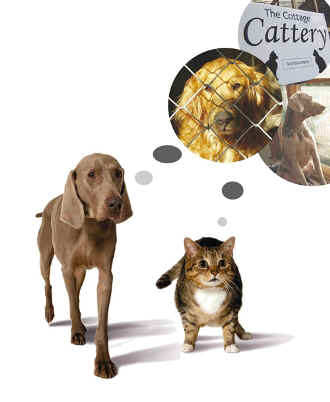 help manage stress in cats and dogs. It
can also help you pet adapt to change. Zylkčne is natural, palatable and easy to give
with food and only needs to be given once daily. help manage stress in cats and dogs. It
can also help you pet adapt to change. Zylkčne is natural, palatable and easy to give
with food and only needs to be given once daily.
Zylkčne contains a-casozepine, a protein made from cow's
milk, which has relaxing properties. It can be used both for short-term stress, eg
kennel or cattery stay, fireworks, or long-term eg multi-cat household.
Zylkčne should be started 1-2 days before the fireworks are
anticipated. It can then be continued throughout the firework period and then stopped.
What can you do straightaway?
Provide a den or hiding place, a "bolt hole" -
animals naturally hide when they are scared and it can help to provide a "safe place"
which they can squeeze into, like an understairs cupboard or an indoor kennel with blankets over
the top and inside.
Muffle the sound of the fireworks - close curtains,
shut outside doors and windows, and have your pet as near to the centre of the house as possible.
Put on the TV or radio to mask the sound.
Keep them inside - don't let pets outside when
fireworks are likely or during a display. Take dogs out for toilet purposes before it gets
dark and then keep them in. A firework going off when they are outside can lead to a fear of
going out.
Don't over-fuss them - This can be difficult, but if
they rely on you for comfort during scary events, they will be less able to cope when you are not
at home and make matters worse in the long term.
Stay calm yourself - most pets can sense when their
owners are worried, and this increases their stress. Let them hide in the den, and leave
them there until the fireworks have finished and they come out. You can give your pet lots
of fuss once they emerge.
Don't get angry - although your pet's behaviour may
be annoying it is happening because they are scared and getting cross will only make them worse.
Don't try and take your pet out of its hiding place - this increases their stress and could
lead to aggression.
Prepare for unusual behaviour - fear can make your
pet behave out of character. For example, if they anticipate that going into the garden
predicts a loud noise, they may hide or show aggression to avoid going outside.
Talk to us - we can advise
short-term measures wshich may include medications, particularly if they don't settle but pace
around in distress. This will help reduce you pet's stress during upcoming firework events
and help prevent their fears becoming worse.
|
|
|